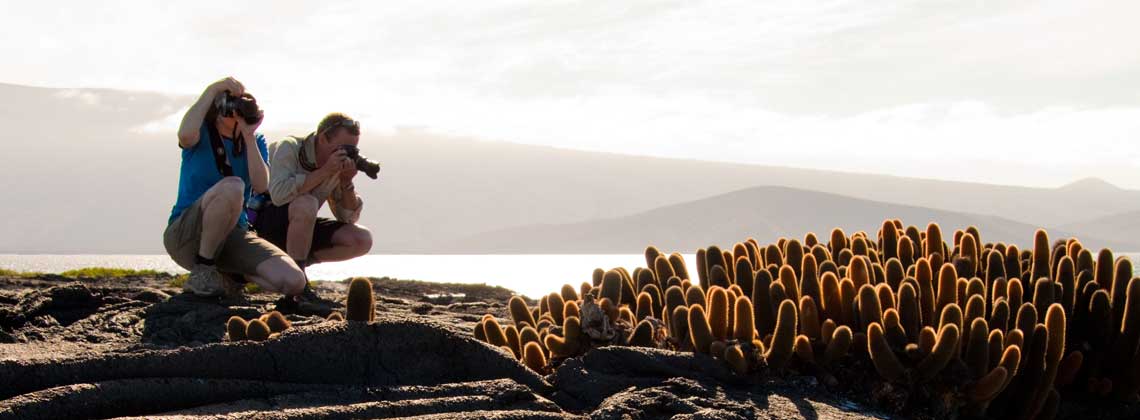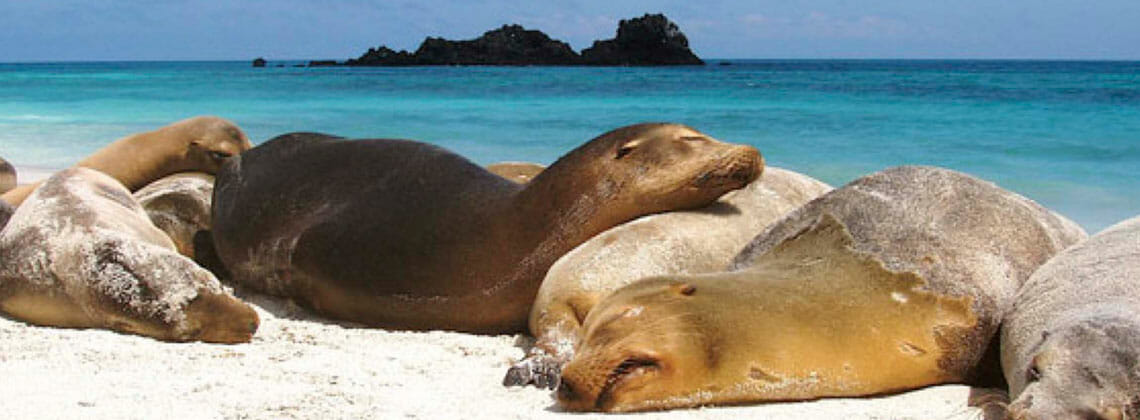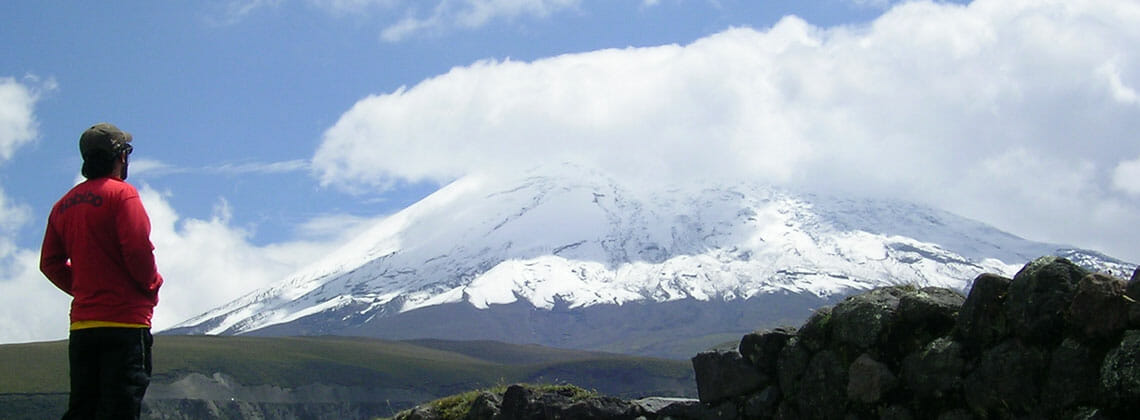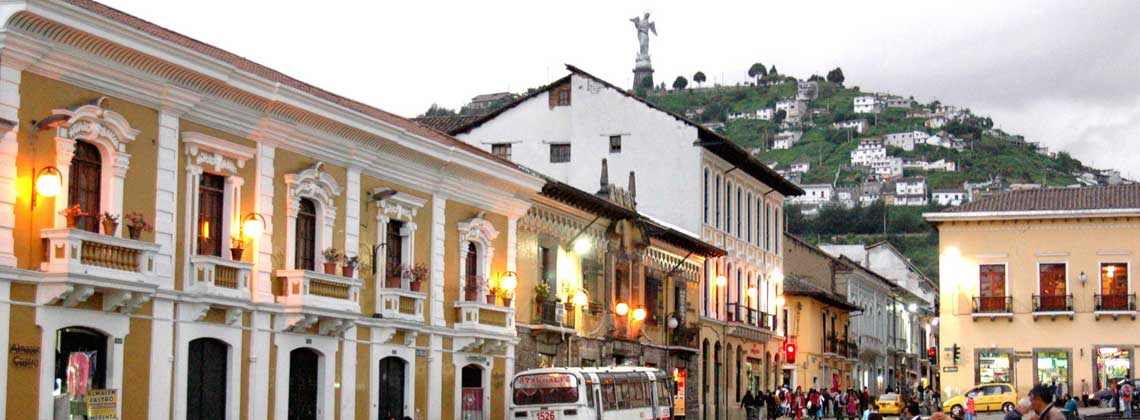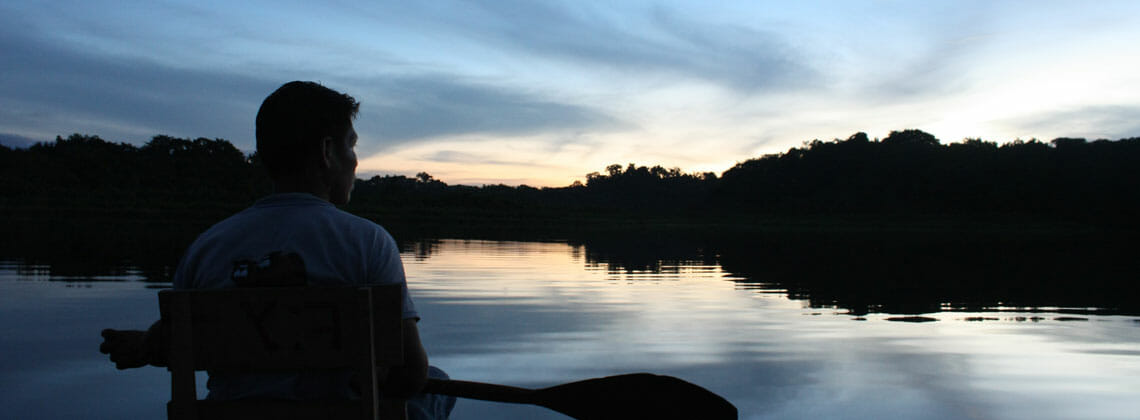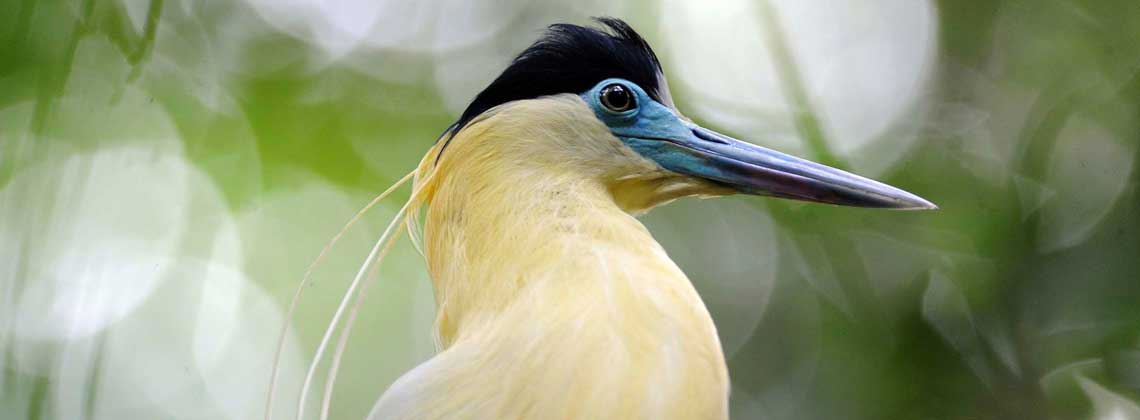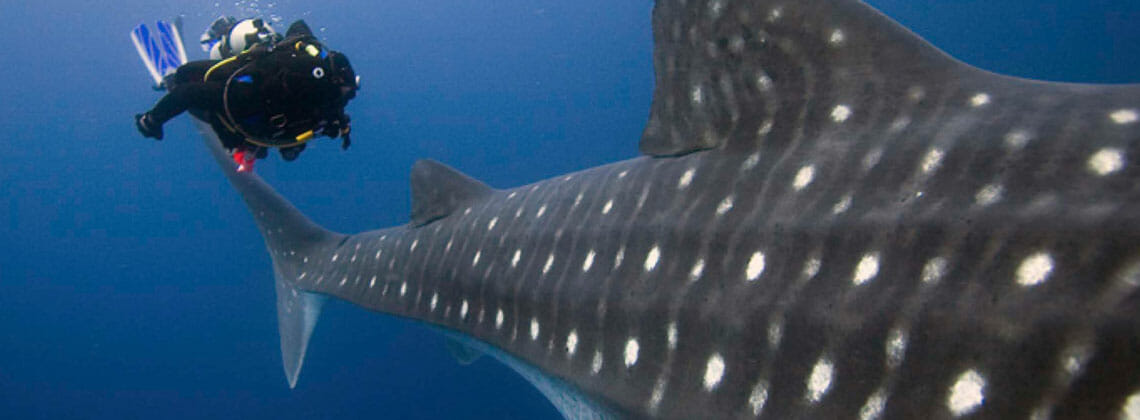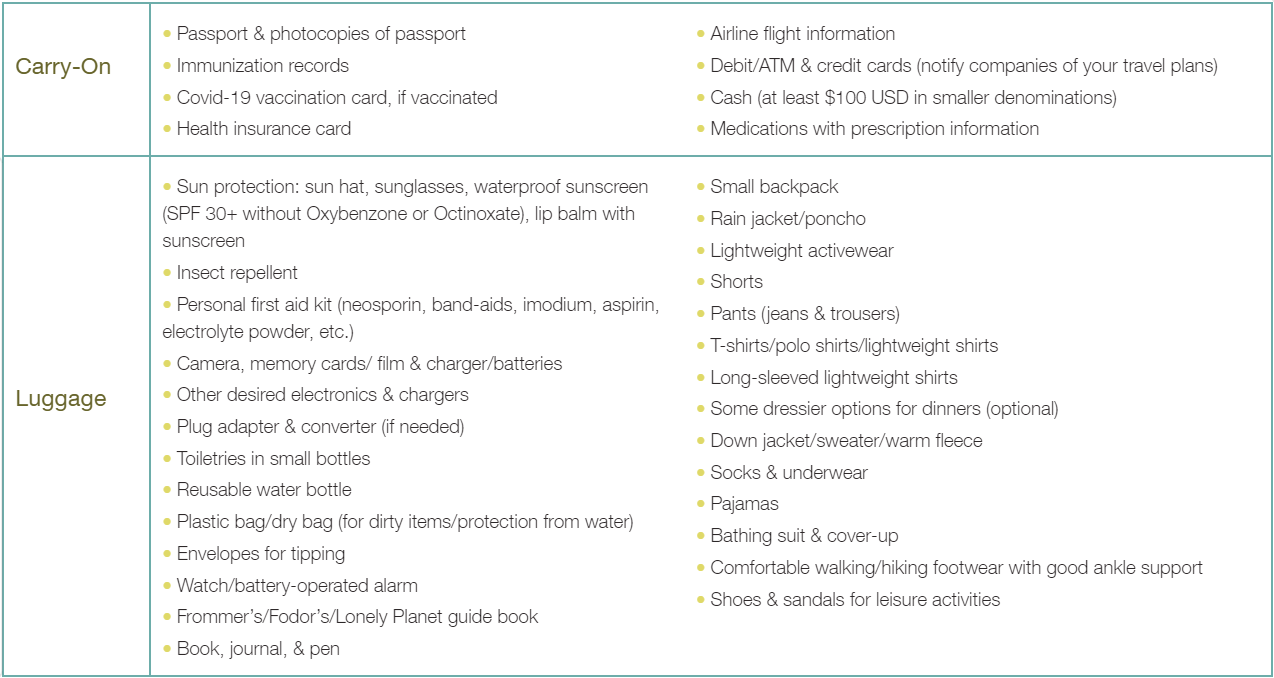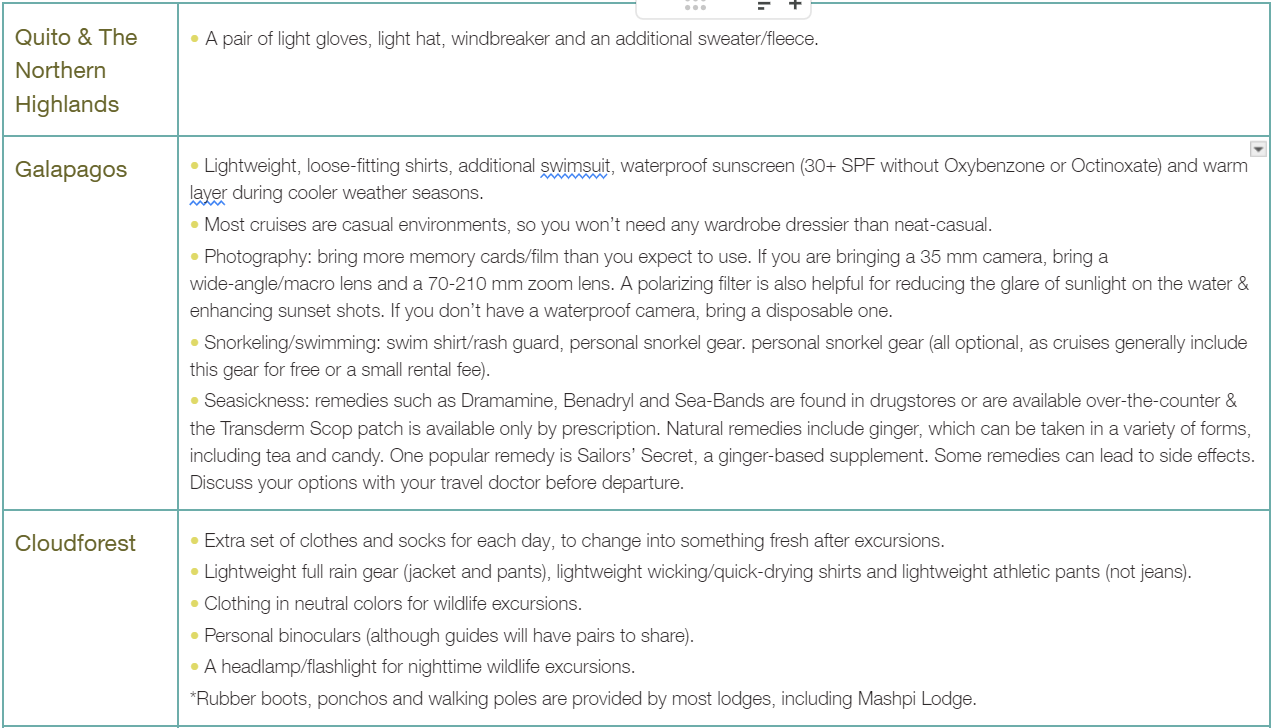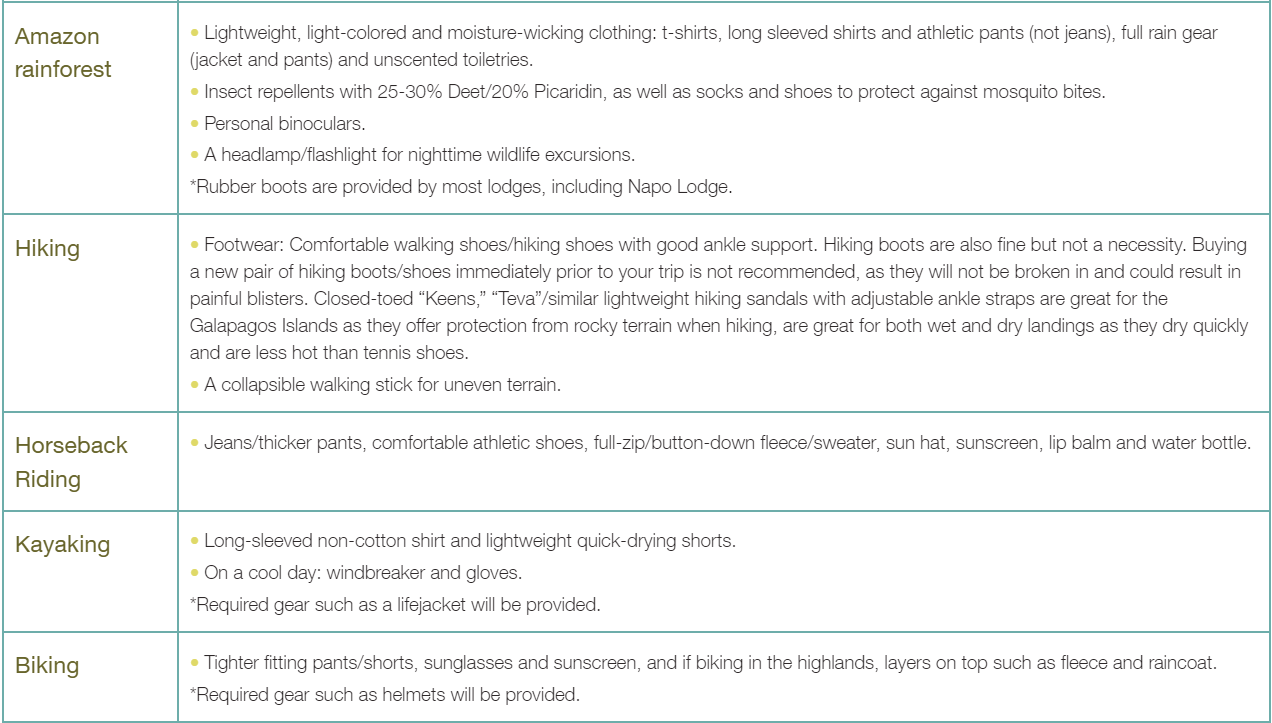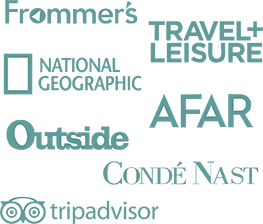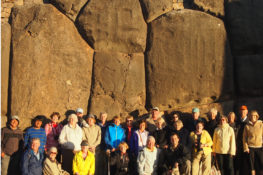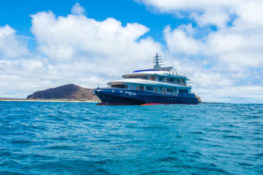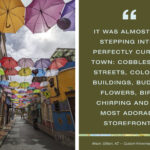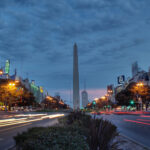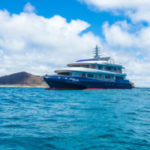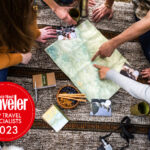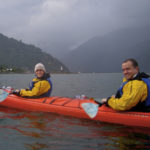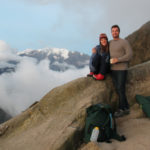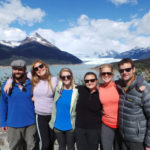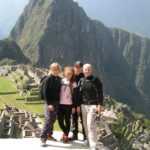- No visas/reciprocity fees needed for U.S. and Canadian citizens to enter Ecuador.
- Upon arrival in Ecuador, U.S. and Canadian citizens will be granted a 90-day tourist visa at no cost.
- Proof of onward travel (i.e. return flight tickets) may be required.
- Minors traveling without parents/guardians may need additional documents. Visit Travel.gov for more info.
- Be up to date on routine vaccinations.
- Visit the Centers for Disease Control for more info.
- Pregnant women are not advised to travel to Ecuador.
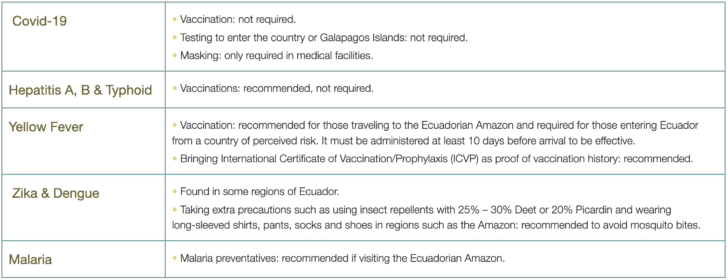
- The official currency is the U.S. dollar.
- Bring a large sum of cash in varying denominations for tipping, souvenirs, and any meals not included in your itinerary. Keep small bills on hand, as it can be difficult to change bills of $20 or larger. For most cruises, tips and discretionary costs must be paid for in cash as only a few cruise boats have credit card capabilities.
- ATMs are the easiest way of getting cash in Ecuador. Make sure you have a four-digit PIN, as many Ecuadorian ATMs do not recognize longer ones. The safest and most secure ATMs are those found inside banks, malls or airports. Please note that ATMs can sometimes run out of cash and are difficult to find in more remote areas, such as the cloud forest or near haciendas and there are no ATMs in the Amazon. In the Galapagos there are no ATMs at the Baltra airport but a few on Santa Cruz Island and one on San Cristobal; however, bringing cash with you from the mainland is recommended, as most cruises do not allow for time to stop at ATMs. If you have questions or encounter issues, your guide can assist you.
- Tips in Ecuador are seen as a bonus.
- Use the following only as a framework and tip based on the level of service you receive.
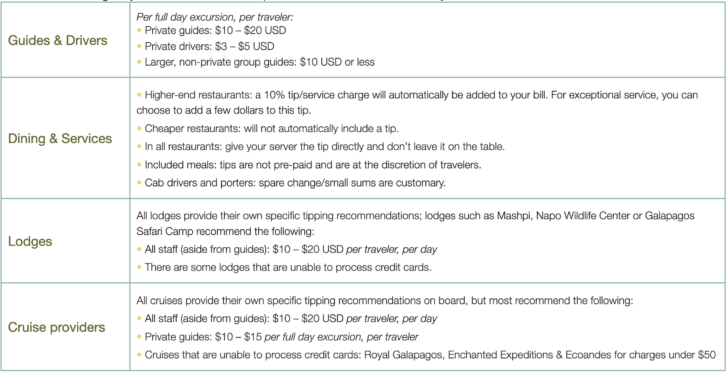
- Trip insurance is not included in your trip cost. Knowmad highly recommends insuring your trip, as the unforeseeable is just that, unforeseeable. A few days after confirming your trip you will receive an email from our recommended travel insurance provider with a pre-built quote that you may purchase.
- U.S. travelers will not typically need a converter or adapter, as plugs are usually the 2-pronged flat type.
- Ecuador has the same electric system as the United States, providing 110 volt, 60 hz cycle electricity.
- Plan to disconnect, as any cell service is intermittent and unreliable. Depending on your service provider, you may get some service only when you are close to the four main towns in the islands.
- Cruises: Wi-Fi is not available on most. Some offer Wi-Fi, but often charge significant extra costs for it, and the signal can still be quite weak. In case of an emergency, there is a satellite phone on board all cruises.
- Hotels: Most do have Wi-Fi.
- Using bottled water for drinking and brushing your teeth is recommended, as tap water is generally not safe to drink.
- Request your beverages without ice (“sin hielo”) while at restaurants, as the ice may not be made with purified water.
- Avoid eating the skin of raw fruits/vegetables (apples, salads, etc.) and any dairy products that have been sitting out.
- Most cruises provide bottled water in your room, serve purified water and ice, and will refill your bottles with purified water upon request.
- Hotels provide purified water from dispensers, bringing a reusable water bottle on your trip is recommended.
Ecuador is considered a safe country, but petty crime does occur. Take the following precautions:
- Non-violent demonstrations are common in Ecuador and should be avoided.
- When dining out at night in Old Town, Quito, ask your hotel concierge if they recommend walking or taking a taxi to your destination. Have your accommodations or restaurant call you a taxi rather than getting one yourself.
- Be aware of your surroundings, always keeping a close eye on your belongings, especially in crowded places.
- Use a bag that zips, doesn’t hang loosely and when in crowds, move it to the front of your body.
- Avoid wearing flashy/expensive jewelry/watches.
- Carry only the money you need each day. Keep the rest with your valuables in your hotel room’s safety deposit box.
- Check out the U.S. State Department travel advisories for the latest information.
- In continental Ecuador, temperature is most often a result of altitude and therefore varies widely among the different regions.
- Even when temperatures seem cool, it is important to remember that the equatorial sun is at a high intensity year round, so please take precautions to protect yourself from the sun.
Check with your carrier and refer to your ticket booking details for information on baggage restrictions and fees.
- LATAM Airlines
- TAME
- Avianca
- For inter-island flights within the Galapagos e.g. from Santa Cruz Island to Isabela Island, the baggage limit is 25 lbs per person. Additional weight must be paid in advance. Please ask your Operations Specialist for additional information or for assistance arranging this.
Knowing a lot about a country before you travel there can enrich your travels and help you meet and relate to more local people. To learn more about Ecuador’s history, culture, and people we recommend consulting travel guide books, online websites, and travel blogs.
Meals at restaurants in Ecuador are meant to be enjoyed and expected to be unrushed. You will have to ask for the check, as it’s considered rude to provide a check without the patron having requested it. In Ecuador, there is a VAT tax (currently 12%) that will be added to your bill. Additionally, in many higher-end restaurants a 10% tip will be automatically added to your bill.
Price guide for the approximate cost of a main dish at each restaurant (please note that prices and restaurant hours are subject to change without notice): $ = Under 10 $$ = 10-20 $$$ = 20-40 $$$$ = Over 40
Covid-19 has affected restaurants’ hours of operation in South America as in the United States. Please refer to their websites for additional information and to make a reservation, as doing so may require you to enter payment information to confirm the reservation. We recommend making reservations at least 2 months in advance for the Christmas, New Year’s, and Easter holiday dates; and further in advance if looking to dine at a particular restaurant. If calling or making reservations from outside of Ecuador dial +593 before the complete phone number.
QUITO – OLD TOWN
- CASA GANGOTENA RESTAURANTE – Price: $$$ Savor unique culinary creations inspired by Ecuador’s rich and diverse ingredients at this restaurant located in a historic mansion-hotel.
- CAFÉ PLAZA GRANDE – Price: $$ With an excellent location on Plaza Grande, this café serves traditional Ecuadorian fare in an elegant setting.
- PIM’S – Price: $$-$$$ Under the Virgin Statue on Panecillo hill, this restaurant serves Ecuadorian food accompanied by an amazing view of the city. A taxi to this restaurant is recommended.
- LA VID – Price: $$-$$$ Situated next to the Plaza de Indepencia, this restaurant serves international cuisine for a metropolitan meal.
QUITO – NEW TOWN
- URKO – Price: $$$$ Urko provides a sophisticated, contemporary twist on Ecuadorian food with their tasting menu that changes with every season; fertility, harvest, flowering and sowing.
- ZAZU – Price: $$$-$$$$ Splurge on a first-class service and gastronomic experience at Zazu, where an innovative South American menu is served.
- LA GLORIA – Price: $$-$$$ Delicious Mediterranean fusion dishes and a good selection of wines in a modern dining room.
- QUITU – Price: $$$$ A small intimate restaurant which offers a tasting menu of either 8 or 13 courses, with innovative cuisine made with traditional ingredients.
- KRIOLLO – Price: $$$ Made by Michelen star chefs Carolina Sánchez and Iñaki Murua, this restaurant offers high-end Ecuadorian food made with local ingredients.
- CARDO – Price: $$$ High-end international cuisine with a focus on the natural essence of their ingredients.
CUENCA
- RESTAURANTE EL JARDÍN – Price: $-$$ Located in Hotel Victoria, El Jardín has delighted diners for 35 years with beautifully served traditional plates and lovely views of the Río Tomebamba.
- A PEDIR DE BOCA – Price: $ Southeast Asian cuisine in large portions dominates the menu at this charming popular restaurant.
- DOS SUCRE – Price: $$-$$$ Ecuadorian comfort food using mostly organic ingredients from nearby farmers. You can choose from a 5 course tasting menu or à la carte options.
- EL MERCADO – Price: $$-$$$ For a special evening out, make sure you make a reservation at this contemporary upscale restaurant with a menu based on in-season ingredients.
- MOLIENDO CAFÉ – Price: $ Arrive early for a table at this popular Colombian café, known for its arepas, friendly atmosphere, and fixed-priced lunch (no reservations are accepted).
- TIESTO’S CAFÉ RESTAURANT – Prices: $$ The chef at Tiesto’s is often found giving recommendations at this Ecuadorian-fusion restaurant known for its large portions.
- LE PETIT JARDÍN – Price: $$ A hidden gem in the forest just outside of the city, take a taxi to Le Petit Jardín for delicious, rustic food in a beautiful setting.
PUERTO AYORA, SANTA CRUZ ISLAND
- FRAFRE GASTROBAR – Price: $$-$$$ Urban cuisine and seafood with a global influence, located on the main road.
- BAHIA MAR – Price: $$-$$$ Started by Isla Grill, this sister restaurant offers waterfront dining to go along with seafood dishes. By many, it’s considered the best food in Puerto Ayora.
- ISLA GRILL – Price: $$$ A popular grill house known for its family-friendly atmosphere with a menu that features pizza, seafood, and barbecue.
- AGAVE STUDIO – Price: $$ Mexican-Ecuadorian cuisine with many vegetarian and vegan options in a casual setting.
- ALMAR – Price: $$-$$$ Started by Isla Grill, this sister restaurant offers waterfront dining to go along with seafood dishes. By many, it’s considered the best food in Puerto Ayora. Located in Red Mangrove Hotel.
- VILLA LUNA – Price: $-$$ Ecuadorian and international cuisine prepared with fresh, local ingredients at an accessible price.
PUERTO BAQUERIZO, SAN CRISTOBAL ISLAND
- POST OFFICE – Price: $$-$$$ Restaurant with various options of meat and seafood, their own line of beers and a view of Bahia de los Lobos from the patio.
- GIUSEPPE’S – Price: $$-$$$ Enjoy the family-friendly atmosphere and delicious pizza, seafood, and more at this Italian spot.
- MUYU GALAPAGOS – Price: $$-$$$ Enjoy innovative, sustainable seafood dishes as well as vegetarian and vegan options at this upscale farm-and sea-to-table restaurant overlooking the harbor.
PUERTO VILLAMIL, ISABELA ISLAND
- BOOBY TRAP – Price: $$-$$$ This laid-back restaurant has a good selection of food including pizzas, fish tacos, and desserts along with some great drinks. For the chocolate lovers out there be sure to try their delicious homemade brownie.
- ISABELA GRILL RESTAURANT – Price: $-$$ This grill is a good option for a barbecue experience. They serve up big portions of meat and seafood cooked on a charcoal grill.
- SOY BONSAI – Price: $$ Large menu filled with vegetarian and vegan options.
- THE BEACH – Price: $$-$$$ A great place to enjoy the beach while having traditional Ecuadorian food.
- SHAWARMA HOT – Price: $-$$ Known for shawarma and typical dishes like fried rice and seafood, this restaurant fills up quickly so be sure to be there for lunch at 12 to get a spot.
- GRACIAS MADRE – Price: $$ Mexican food with vegetarian, vegan and gluten free options highlighted on the menu.
- LIVING POOR by Moritz Thomsen is written by a 48-year-old Peace Corps volunteer. Thomsen’s eloquent and often humorous tale is a portrait of Ecuadorian culture.
- MEMORY OF FIRE by Eduardo Galeano tells the history of the Americas in poetic prose and a unique style of nonfiction history.
- POLVO Y CENIZA (DUST AND ASHES) by Eliecer Cardenas is a critically acclaimed modern work that attempts to dig up an Ecuador buried and forgotten.
- CANAR: A YEAR IN THE HIGHLANDS OF ECUADOR by Judy Blankeship focuses on the indigenous culture of a remote Andean village.
- THE PANAMA HAT TRAIL by Tom Miller is a fascinating account about the author’s search for the origin of the Panama Hat, which is actually native to Ecuador.
- THE MAPMAKER’S WIFE: A TRUE TALE OF LOVE, MURDER, AND SURVIVAL IN THE AMAZON by Robert Whitaker grips readers reconstructing a scientist’s wife’s 18th-century journey from the Andes to the Amazon.
- TROPICAL NATURE by Adrian Forsyth and Ken Miyata is a collection of stories by two neotropical biologists who did much of their research in Ecuador, and is a favorite of natural-history and wildlife buffs.
- BIRDS, MAMMALS, AND REPTILES OF THE GALAPAGOS ISLANDS by Andy Swash and Rob Still is a fully illustrated, descriptive, colorful and user-friendly guide to Galapagos fauna and birdlife.
PHRASES
- Buenos dias (BWEH-nohs DEE-ahs) – Good morning, Good day
- Buenas tardes (BWEH-nahs TAR-dehs) – Good afternoon
- Buenas noches (BWEH-nahs NOH-chehs) – Good evening
- Por favor (POHR fah-VOHR) – Please
- Gracias (GRAH-syahs) – Thanks
- ¿Cuánto cuesta esta? (KWAHN-toh KWEHS-tah EHSS-tah) –
- How much does this cost?
- ¿Dónde está ____? (DOHN-deh ehss-TAH ___) – Where is ____?
- ¿Habla inglés? (AH-blahs een-GLEHS) – Do you speak English?
- ¿Qué recomienda? (KEH reh-coh-mee-EHN-dah) – What do you recommend?
- Soy alérgico/a a ____ (soy ah-LEHR-hee-coh/-cah ah ____) – I’m allergic to ____
AT THE TABLE
- La carta (lah KAHR-tah) – the menu
- La cuenta (lah KWEHN-tah) – the check
- Agua (AH-gwa) – water
- Café (kah-FEH) – coffee
- Cerveza (sehr-VAY-sah) – beer
- Vino (VEE-noh) – wine
- Pescado y marisco (pehs-KAH-doh ee mah-REES-kohs) – fish and seafood
- Pollo (POH-yoh) – chicken
- Carne (KAHR-nay) – meat
- Vegetariano/a (veh-heh-tah-RYAH-noh/-nah) – vegetarian
- Sin gluten (seen GLOO-tehn) – gluten-free
Have a question that you can’t find an answer to on our site? Or if you’d simply like to ask a real, live person your questions instead of browsing through these FAQ sections, we are more than happy to help. Just give us a call at 612-315-2894 or email [email protected].



